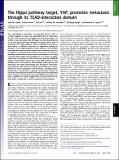The Hippo pathway target, YAP, promotes metastasis through its TEAD-interaction domain
Author(s)
Stern, Patrick; Liu, Hui; Schindler, Jeffrey W.; Jiang, Zhigang; Lamar, John; Hynes, Richard O; ... Show more Show less
DownloadLamar-2012-The Hippo pathway ta.pdf (1.607Mb)
PUBLISHER_POLICY
Publisher Policy
Article is made available in accordance with the publisher's policy and may be subject to US copyright law. Please refer to the publisher's site for terms of use.
Terms of use
Metadata
Show full item recordAbstract
The transcriptional coactivator Yes-associated protein (YAP) is a major regulator of organ size and proliferation in vertebrates. As such, YAP can act as an oncogene in several tissue types if its activity is increased aberrantly. Although no activating mutations in the yap1 gene have been identified in human cancer, yap1 is located on the 11q22 amplicon, which is amplified in several human tumors. In addition, mutations or epigenetic silencing of members of the Hippo pathway, which represses YAP function, have been identified in human cancers. Here we demonstrate that, in addition to increasing tumor growth, increased YAP activity is potently prometastatic in breast cancer and melanoma cells. Using a Luminex-based approach to multiplex in vivo assays, we determined that the domain of YAP that interacts with the TEAD/TEF family of transcription factors but not the WW domains or PDZ-binding motif, is essential for YAP-mediated tumor growth and metastasis. We further demonstrate that, through its TEAD-interaction domain, YAP enhances multiple processes known to be important for tumor progression and metastasis, including cellular proliferation, transformation, migration, and invasion. Finally, we found that the metastatic potential of breast cancer and melanoma cells is strongly correlated with increased TEAD transcriptional activity. Together, our results suggest that increased YAP/TEAD activity plays a causal role in cancer progression and metastasis.
Date issued
2012-09Department
Massachusetts Institute of Technology. Department of Biology; Koch Institute for Integrative Cancer Research at MITJournal
Proceedings of the National Academy of Sciences of the United States of America
Publisher
National Academy of Sciences (U.S.)
Citation
Lamar, J. M. et al. “The Hippo Pathway Target, YAP, Promotes Metastasis Through Its TEAD-interaction Domain.” Proceedings of the National Academy of Sciences 109.37 (2012): E2441–E2450. CrossRef. Web.
Version: Final published version
ISSN
0027-8424
1091-6490